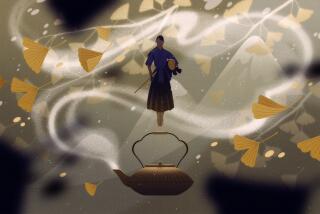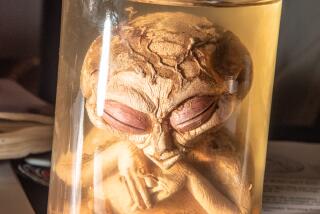In Touch With the Beyond--or Is It Balderdash? : Occult: Skeptics caution those who use Ouija boards that the spirit they call up may be more haunting than helpful.
- Share via
You want scary?
When Deborah Crowley was about 16, she began messing around with a Ouija board somebody had picked up at a dime store.
She and her friends asked the board questions and found themselves apparently in touch with a male spirit who entertained romantic impulses toward Crowley. What a riot.
But Crowley started having some peculiar experiences. She felt something touch her when nothing was there.
And one night--there was a thunderstorm, of course--Crowley was baby-sitting, alone, and she had a little session with the board. The spirit turned up, but it was hostile.
“It was threatening it was going to hurt me,” Crowley says.
She threw the Ouija board away, and that was that. Today, she warns people against messing around with it, because you never know what or whom you are going to stir up.
What makes the story a little unusual is that Crowley didn’t lock the door to the spirit world. Au contraire ; she is founder and director of the Inner Light Center, an interfaith spiritual center in Rocky Hill, Conn. She does readings and healings, but she doesn’t call herself a psychic because “I believe everybody is psychic,” although some folks are more naturally sensitive than others, she says.
Ouija boards--first introduced in the 1890s--have always had their detractors. Fundamentalist Christians have denounced them as gateways to the devil. (Indeed, in the book and movie “The Exorcist,” a Ouija board is the means by which the devil gains access to young Regan.) Scientific skeptics have ridiculed them as nonsensical toys.
But how about the New Age movement, especially the element that embraces spiritual seeking and magic and channeling and sundry other elements of the occult? Wouldn’t those people be steadfast Ouijaphiles?
Nope. Most of them share Crowley’s misgivings.
“Supposing you were living in a brownstone apartment in New York City, and you walk out the door and grab the first person you see and bring them into your home,” says Roger Pile of Ivoryton, Conn., a psychic who offers help with possessions and hauntings.
Pile says you’re doing much the same thing when you buttonhole any old entity from the busy boulevards of the spirit world, and you have no right to expect that the spirit you contact on the Ouija board will have Letitia Baldrige manners.
“Most people will say: ‘Who’s out there?’ ” says Pile. “Because of its primitiveness, the Ouija board is more susceptible to the more un-evolved types of astral energy. I call them turkeys. They’re all for fun and games. They’ll get on the board and tell you you were a king in a former life. They get petulant. They get threatening.”
A regulation Ouija board consists of a sliding pointer, called a planchette, plus an array of the letters of the alphabet, all the single-digit numbers and the words Yes , No and Goodbye .
The planchette came first. Usually a heart-shaped piece of wood on casters, the planchette was born in France and began turning up in the United States in the 1850s in the parlors of people who wanted to commune with spirits.
*
The idea was that one or more people would place their hands on the planchette, and magnetic forces would cause it to move in the way the spirits wished. Some planchettes wrote with pencils. Others pointed at letters.
*
In the 1890s, two different Maryland toy makers combined the planchette with a board to produce a game originally known as “witch board.” One story is that ouija was an Egyptian word for “good luck.” The more likely version is that William and Isaac Fuld, the eventual patenters of the board, combined the words oui and ja, both meaning “yes.”
Parker Brothers bought the rights to the board from the Fuld family in 1967, and since then they’ve sold millions of Ouijas, says a company spokeswoman. The official stance of Parker Brothers is that this is a game, that it has no more supernatural powers than Monopoly or Clue.
*
Scientific skeptics claim the board works through an “idiomotor action” similar to what happens with dowsing rods.
“Unconsciously picturing what you want to have happen can cause your muscles to make it happen,” says Ray Hyman, professor of psychology at the University of Oregon. “People think they’re not doing anything and that some outside force is making it happen.”
Boyce Batey of Bloomfield, Conn., has been a psychical researcher for decades and--like Pile and Crowley--is known as one of the people one might turn to if one’s Ouija board ever got out of hand.
Years ago, Batey says, he was approached by a woman who had been the mistress of a rabbi who had died. The woman missed the rabbi intensely, and one day she found herself tinkering with a Ouija board. After a while it began spelling out messages that seemed to come from the rabbi.
“It became almost an obsession for her to sit for four or five hours a day with the board,” Batey says. “What was coming through convinced her it was he and gave her the kind of fulfillment she needed.”
After a while, though, the nature of the messages began to change, to turn hostile and obscene.
“She felt it was not the rabbi at all; it was a mischievous spirit that had contacted her subconscious mind, saw what need she had--and then assumed the role of the rabbi in order to continue contact with her,” Batey says.
By the time the woman came to him, she believed she had a demonic entity on her hands and was very frightened. Batey says he never satisfied himself about whether the entity was real or some kind of projection from her troubled subconscious. But he convinced her to throw the board away.
On the brighter side, Ouija boards have produced some interesting literature.
Perhaps the most heralded example began in 1913, when a bored St. Louis housewife named Pearl Curran was Ouijafying with some friends, as was her wont in those days.
Suddenly, the planchette responded with unusual strength and spelled out the message, “Many moons ago I lived. Again I come--Patience Worth my name.”
What followed was a strange relationship that lasted for decades as “Patience Worth,” apparently the spirit of a young woman from the 17th Century, began spelling out poems, aphorisms and even entire novels, all of the work of surprisingly high quality, much of it using very antiquated language, and all of it far beyond the ken of Pearl Curran, who had never exhibited a shred of literary talent or enthusiasm.
Several of “Patience Worth’s” books were published, most notably “The Sorry Tale,” a biblical novel that was favorably reviewed by many newspapers.
Spiritual seekers in the New Age world not only regard the board as dangerous in foolish or untutored hands, but they also regard it as the horse and buggy of channeling, which is now done more often through meditation and trance states (although some famous channelers discovered their gifts while monkeying around with Ouija boards).
John Roe, editor of the Door Opener, a Vernon, Conn.-based journal about spiritual concerns, says: “Channeling is so commonplace, and so many people do it, that they have kind of bypassed the Ouija board as being too slow.”
More to Read
Sign up for Essential California
The most important California stories and recommendations in your inbox every morning.
You may occasionally receive promotional content from the Los Angeles Times.










